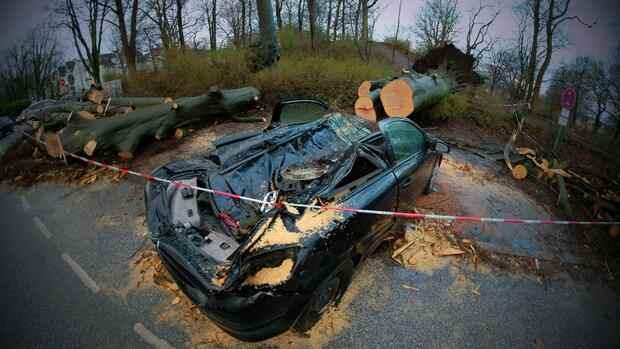Losses from natural disasters are expected to be above average again this year.
(Photo: dpa)
Frankfurt German property-casualty insurers are again burdened by high damage costs from natural catastrophes this year. “From an earnings perspective, 2022 is likely to be another difficult year for the industry,” said Dennis Wittkamp, specialist coordinator of property-casualty insurance at the rating agency Assekurata, when presenting a market outlook for the industry.
As a result, consumers will have to reckon with rising premiums in the future, especially in residential building insurance and motor vehicle insurance.
This year, however, insurers will only benefit to a limited extent. Assekurata expects market-wide premium growth for German property-casualty insurers of 1.7 percent to EUR 77.9 billion in 2022.
“The ongoing war in Ukraine and the disruptions to supply chains caused by the pandemic are currently dampening the economic recovery,” explains Wittkamp. In 2021, premiums rose by 2.2 percent, and by around 2.9 percent on a long-term average.
Top jobs of the day
Find the best jobs now and
be notified by email.
Allianz is somewhat more optimistic and, according to a recent study, expects property insurance to grow by 2.3 percent in the German insurance market in 2022. But even with that, the industry is lagging behind the providers in Western Europe. Here, Allianz expects premium growth of 3.1 percent on average.
The results of German property-casualty insurers in the past year were primarily impacted by the high claims burden caused by the devastating flood in the Ahr valley. The combined claims/expenses ratio, i.e. the ratio of costs and expenses to premium income, increased from 90.7 percent to around 102 percent in 2021. In 2021, the industry was in the red for the first time in a long time – the underwriting loss was around 1.5 billion euros.
Reinsurance protection is becoming more expensive
It is positive that a significant part of the natural hazards is reinsured. “This provides significant relief for primary insurers, but should have an impact on the price of reinsurance protection in the medium term,” expects Assekurata Managing Director Reiner Will.
From the point of view of the Assekurata experts, it is also problematic that the earnings situation of the individual insurers has long been very different. Even in years with low natural catastrophe losses, some companies are not able to sustainably increase premiums and break even.
Residential building insurance, which Will describes as a renovation case, is particularly affected. Water damage and fire damage therefore remain a permanent cost driver. Damage from natural disasters is also likely to be above average again in 2022. There were already several strong storms in the first quarter, followed by severe storms in western Germany in May.
>> Read also: Countries want compulsory insurance for elementary damage to buildings
Added to this is the high level of inflation: Customers must therefore expect price increases in this segment in the current and next year. “Here, inflation in the construction industry in particular has a direct effect on the premium to be paid via the construction price index,” emphasizes Will.
Maximilian Happacher, Deputy Chairman of the Board of Directors of the German Association of Actuaries (DAV), recently referred to “extremely increased material and craftsman costs”. In contrast to Assekurata, he did not want to derive a general forecast for future premium development from the data. The scope and speed of price adjustments are highly company-specific, he said.
Despite higher premiums, Will expects homeowners insurers to be able to increase the number of contracts more significantly in 2022 than in the past. After the flood disaster in the Ahr Valley, more people were ready to protect their homes against natural hazards. However, the insurance association GDV recently complained that the demand for natural hazard insurance, which had increased noticeably after the catastrophe, had fallen again significantly.
In contrast to residential building and legal expenses insurance, which has been struggling with profitability for years, the other lines of business reported premium growth and claims-cost ratios of less than 100 percent last year, according to Assekurata.
Motor insurers compete in a shrinking market
This even includes motor vehicle insurance, although it was also heavily burdened by the storm damage in the comprehensive area. According to Wittkamp, however, insurers have benefited from the lower claims burden in motor liability, which is mainly due to the pandemic and people’s reduced mobility.
But here, too, the Assekurata experts anticipate rising premiums for the insured. “Inflation for spare parts, which is generally well above normal inflation, is likely to cause insurers’ claims burdens to rise further and thus require premium increases at the end of the year,” Wittkamp is convinced.
At the same time, weaker contract growth is to be expected. Since new registrations and transfers of ownership fell noticeably in the first quarter of 2022, motor insurers are likely to be dealing with a shrinking market for the first time in a long time.
More: High inflation is becoming a problem for property-casualty insurers and their customers

